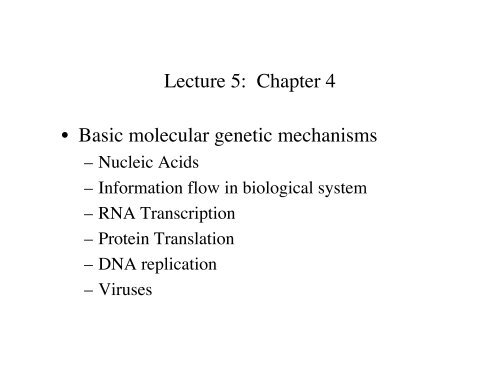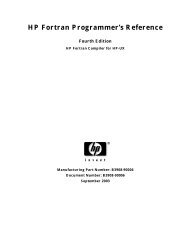Lecture 5: Chapter 4 • Basic molecular genetic ... - Genome Tools
Lecture 5: Chapter 4 • Basic molecular genetic ... - Genome Tools
Lecture 5: Chapter 4 • Basic molecular genetic ... - Genome Tools
You also want an ePaper? Increase the reach of your titles
YUMPU automatically turns print PDFs into web optimized ePapers that Google loves.
<strong>Lecture</strong> 5: <strong>Chapter</strong> 4<br />
<strong>•</strong> <strong>Basic</strong> <strong>molecular</strong> <strong>genetic</strong> mechanisms<br />
– Nucleic Acids<br />
– Information flow in biological system<br />
– RNA Transcription<br />
– Protein Translation<br />
– DNA replication<br />
– Viruses
<strong>•</strong>Classic EM DNA and RNA txn
<strong>•</strong>EM nucleolus, RNAP and rRNPs<br />
<strong>•</strong>“old” = heavy and radio isotopes probes<br />
<strong>•</strong>“new” = fluorescent and luminescent probes
Biochemistry inside the cell<br />
<strong>•</strong>Central Dogma
Nucleotides: Common structure
Anti vs syn
Why DNA and not RNA, if they are the same?<br />
<strong>•</strong>1) RNA less stable under certain conditions<br />
<strong>•</strong>Alkaline<br />
<strong>•</strong>2) C-OH more reactive, than C-H<br />
<strong>•</strong>3) Polymer- larger grooves, more accessible by enzymes<br />
<strong>•</strong>4) also, hereditary base info POV difference
Chargaff’s Rules<br />
<strong>•</strong>Review article, 1950” ‘Chargaff’s Rules’ - ‘regularities’<br />
<strong>•</strong><strong>Lecture</strong>d at Cambridge, 1952
<strong>•</strong>1952<br />
<strong>•</strong>Franklin and Wilkins had a general idea what DNA looked like<br />
<strong>•</strong>But “They had done no proper model building”…‘missed the<br />
base pairing and overlooked Chargaff’s Rules’ (Crick)<br />
<strong>•</strong>Pauling built models but didn’t consider Chargaff’s Rules, also did not have crys data<br />
<strong>•</strong>http://www.dnai.org/text/mediashowcase/index2.html?id=66<br />
Plus…
Leads to…<br />
<strong>•</strong>http://nobelprize.org/educational_games/medicine/dna_double_helix/readmore.html<br />
<strong>•</strong>http://www.cumc.columbia.edu/news/journal/journal-o/fall-2003/dna.html<br />
<strong>•</strong>Nature, Apr 25, 1953<br />
…leading to…
‘immediate’ answers…<br />
<strong>•</strong>http://nobelprize.org/educational_games/medicine/dna_double_helix/readmore.html<br />
<strong>•</strong>http://www.chem.ucsb.edu/~kalju/chem110L/public/tutorial/intro.html<br />
<strong>•</strong>http://www.dnai.org/text/mediashowcase/index2.html?id=66<br />
<strong>•</strong>Nature, Apr 1953
Leads to…<br />
<strong>•</strong>Two months earlier….<br />
<strong>•</strong>Working to fit cardboard cutouts of the bases into Franklin’s data, Watson…<br />
<strong>•</strong>“Francis kept telling me there’s Chargaff’s pairs; would they pair to each other?”<br />
<strong>•</strong>“But I didn’t like Chargraff… I didn’t want to use his data in finding the structure.”<br />
<strong>•</strong>http://nobelprize.org/educational_games/medicine/dna_double_helix/readmore.html<br />
<strong>•</strong>http://www.cumc.columbia.edu/news/journal/journal-o/fall-2003/dna.html
<strong>•</strong>dsDNA, complementary and anti-parallel
<strong>•</strong>http://www.cumc.columbia.edu/news/journal/journal-o/fall-2003/dna.html
DNA forms: A, B and Z<br />
<strong>•</strong>Right handed<br />
<strong>•</strong>Left handed
Views of the double helix
Using the double helix: Proteins ‘bridge’<br />
nucleic acids to the ‘world’
Using the double helix
What is DNA?<br />
<strong>•</strong>Native vs denatured
Native vs denatured DNA
Using the double helix
Physicochemical characterizations
DNA secondary structures
DNA ‘bridges’ chemistry to life<br />
<strong>•</strong>Double strand to single strand
RNA secondary structures
Why is secondary structure, and stability of, important?<br />
<strong>•</strong>role in structural aspects of complexes<br />
<strong>•</strong>gene expression/transcription regulation<br />
<strong>•</strong>genome regulation (large regions)
Nucleic acids have “3-D” structure<br />
<strong>•</strong>http://nobelprize.org/educational_games/medicine/dna_double_helix/readmore.html<br />
<strong>•</strong>http://www.chem.ucsb.edu/~kalju/chem110L/public/tutorial/intro.html<br />
<strong>•</strong>http://www.dnai.org/text/mediashowcase/index2.html?id=66
Biochemistry inside the cell
Biochemistry of<br />
[or manipulation of] nucleic acids<br />
involve:<br />
<strong>•</strong>template<br />
<strong>•</strong>resolution of double-strand and<br />
<strong>•</strong>secondary structure<br />
<strong>•</strong>chemistry
ACTGGTCAACGTTGCA….. [and?]
Overview of information flow:<br />
Central dogma [paradigm] of <strong>molecular</strong><br />
biology<br />
<strong>•</strong> 1958 Crick<br />
<strong>•</strong> Information flow<br />
<strong>•</strong> Described ‘knowing everything’ about<br />
<strong>molecular</strong> mechanisms inside cell<br />
<strong>•</strong> DNA DNA->RNA->protein
?<br />
Central dogma of <strong>molecular</strong> biology<br />
(but...)<br />
Exceptions:<br />
<strong>•</strong> Temin ‘64 predicted RNA viruses<br />
Temin, Baltimore ‘70 found RTase<br />
<strong>•</strong> Prusiner ~82 “prion”<br />
*There’s more than we know
Central dogma of <strong>molecular</strong> biology<br />
(but...)<br />
Prusiner ~82 “prion in disease”<br />
Prions (kuru, N. Guinea, early ‘00s;<br />
Gadjusek, ‘57; slow virus ‘66)<br />
(BSE; UK, Nov86)<br />
Also,<br />
<strong>Genome</strong> size paradox<br />
‘05 ‘recent’ gene estimates<br />
<strong>•</strong>Monod ‘54, “What was true for E. coli would be true for the elephant.”<br />
-> but, miRNA parallel regulatory system acting on DNA, RNA and protein<br />
–Allows structural complexity in humans?
Exception: CWD and<br />
deer<br />
Oct 5, 2006 EHoover<br />
<strong>•</strong>“Deer spread a brain-destroying disease through saliva”<br />
<strong>•</strong>white-tailed deer at CSU Chronic Wasting Disease Research Facility<br />
<strong>•</strong>saliva from CWD-infected deer to healthy tame from unaffected area<br />
<strong>•</strong>18 month surveillance of tonsil tissue and eventually brain<br />
<strong>•</strong>all deer from saliva exposure as well as single blood transfusion<br />
<strong>•</strong>also, additional work: not just casual contact but contact with environment, eg secretions
ED Belay et al., Emerging Infect Dis 04<br />
Chronic wasting disease of elk and deer in CO, WY, NE<br />
Spread from focus<br />
Food-borne transmission of BSE to humans<br />
Species barrier [?]<br />
Sept 05 WVa, MD?<br />
Apr 06 prions stable in soil<br />
Exception: Protein to protein
<strong>Genome</strong> content paradox<br />
[and elephants and E. coli]<br />
-Resolution as non-coding RNAs (siRNA, RNAi, microRNA)?<br />
-regulatory RNA<br />
2005
Central Dogma of Molecular Biology<br />
[seemingly ‘often refuted’ by new understandings]<br />
<strong>•</strong>Describes ‘information flow inside the cell’<br />
<strong>•</strong>How can this be the ‘Central Dogma’ if it does not hold up?<br />
<strong>•</strong>LMoran blog: http://sandwalk.blogspot.com/2007/01/central-dogma-of-<strong>molecular</strong>-biology.html
Central Dogma of Molecular Biology<br />
[seemingly ‘often refuted’]<br />
<strong>•</strong>Many [younger] scientists or the Recombinant DNA, Molecular Biology and Genomics era<br />
read/studied Watson’s “Molecular Biology of the Gene”<br />
<strong>•</strong>[not many have read the original paper[s]]<br />
<strong>•</strong>LMoran blog: http://sandwalk.blogspot.com/2007/01/central-dogma-of-<strong>molecular</strong>-biology.html
<strong>•</strong>http://sandwalk.blogspot.com/2007/01/central-dogma-of-<strong>molecular</strong>-biology.html<br />
Central Dogma of Molecular Biology<br />
[perception corrected]
<strong>•</strong>Still, prions?<br />
<strong>•</strong>http://sandwalk.blogspot.com/2007/01/central-dogma-of-<strong>molecular</strong>-biology.html<br />
Central Dogma of Molecular Biology<br />
[perception corrected]
Replication: DNA chemistry<br />
<strong>•</strong>Biochemistry as information storage dsDNA, ssDNA
Transcription (txn): RNA chemistry<br />
<strong>•</strong>Biochemistry as mRNA, tRNA and rRNA, also ATP/GTP energy
Transcription (Txn) is RNA from DNA<br />
RNA ‘bridge’ DNA to the ‘world’
<strong>•</strong>Bacterial RNAP<br />
<strong>•</strong>Note DNA bend
Biochemistry of txn: Model process
Current model of RNA polymerase
<strong>•</strong>Refinements thru better<br />
tools, better understanding
RNA transcription: Structural basis<br />
RKornberg, Sci Jun01 x2 articles<br />
<strong>•</strong>Structural basis of transcription @2.8 and 3.3A<br />
<strong>•</strong>RNApol II transcribing a gene<br />
<strong>•</strong>Protein: gray, orange clamp and green bridge<br />
<strong>•</strong>DNA: blue template strd;<br />
<strong>•</strong>green non-template strd<br />
<strong>•</strong>RNA: red;<br />
<strong>•</strong>Mg ++ : pink
A:<br />
<strong>•</strong>Refined Pol II structure<br />
<strong>•</strong>Electron density<br />
<strong>•</strong>Ribbon of 10 subunits<br />
B:<br />
<strong>•</strong>Structure of Rpb1:<br />
<strong>•</strong>domains and domain-like regions<br />
R. Kornberg, Nobel Chemistry 2006<br />
Transcription: Structural and <strong>molecular</strong> basis
<strong>•</strong> Prokaryotes<br />
<strong>•</strong> Eukaryotes<br />
Organization of genes<br />
<strong>•</strong> [using the genome]
DNA to RNA to protein, what and when?
Example of “on/off:” Need tryptophan
Different strategies: Prok vs Euk
Different strategies: Euk
Eukaryotic gene structure in [a little more] detail
RNA transcript processing
Cell type-specific splicing of fibronectin<br />
<strong>•</strong>75 kb gene<br />
<strong>•</strong>Twenty isoforms, glycoprotein, ca 5% carbohydrates, where<br />
<strong>•</strong>EIIIB and EIIA exons encode binding domains for fibroblast surface proteins<br />
<strong>•</strong>Fibroblast mRNA contains both- fibronectin adheres to Extracellular Matrix<br />
<strong>•</strong>Hepatocyte version is missing both- secreted and circulated<br />
<strong>•</strong>during blood clots, fibrin-binding domains bind to fibrin;<br />
<strong>•</strong>complex bind integrins on platelets- cascade
Drosophila to Mammals<br />
<strong>•</strong>Dscam, Ig superfamily member<br />
<strong>•</strong>Isolated by its affinity to Dreadlocks (Dock)<br />
<strong>•</strong>Homolog of mammalian oncogene Nck (appearance of the photoreceptor cell axon projection pattern)<br />
<strong>•</strong>Dscam, Dock, Pak (Ser/Thr kinase) together direct pathfinding of<br />
Bolwig’s nerve, subclass of sensory axons, to target in embryo<br />
<strong>•</strong>Dscam required for formation of axon pathways in embryonic CNS<br />
<strong>•</strong>http://fruitfly.files.wordpress.com/2006/11/fruitfly.jpg<br />
<strong>•</strong>http://sdbonline.org/fly/hjmuller/dscam1.htm
Record alternative splicing<br />
<strong>•</strong>D. melanogaster Dscam gene<br />
<strong>•</strong>[“Down Syndrome cell adhesion molecule”]<br />
<strong>•</strong>Ig superfamily protein<br />
<strong>•</strong>115 exons of which 95 mutually exclusive exons,eg, organized into 4 clusters<br />
<strong>•</strong>exons 4, 6, 9 and 17 clusters contain 12, 48, 33 and 2 mutually exclusive alt exons<br />
<strong>•</strong>38,016 mRNA isoforms for distinct axon guidance receptors<br />
<strong>•</strong>for neuronal wiring specificity (innate immunity)
Good gene, bad gene [?]<br />
(splicing is important also as…)<br />
<strong>•</strong>BCL-X gene (“B-cell lymphoma”)<br />
<strong>•</strong>Normally, sans blue portion of Exon II,<br />
produces Bcl-X S mRNA, a protein that induces apoptosis<br />
<strong>•</strong>If splice to include all Exon II,<br />
produces Bcl-X L mRNA, a protein to inhibit apoptosis<br />
<strong>•</strong> -> Many cancers have high incidence of Bcl-X L<br />
<strong>•</strong> -> Successful chemotherapy results in higher proportion<br />
of Bcl-X S
Euk gene: “editing” post-RNA synthesis<br />
<strong>•</strong>http://en.wikipedia.org/wiki/Apolipoprotein_B<br />
<strong>•</strong>http://en.wikipedia.org/wiki/Messenger_RNA<br />
<strong>•</strong>Some cases,’editing’ occurs<br />
<strong>•</strong>Changing nucleotide composition of mRNA<br />
<strong>•</strong>Ex, human apolipoprotein B mRNA<br />
<strong>•</strong>[primary apolipoprotein of low density lipoproteins (bad)]<br />
<strong>•</strong>Edited in some tissues not in others<br />
<strong>•</strong>Two main isoforms in plasma: APOB48 and APOB100<br />
<strong>•</strong>First by small intestine, second by liver<br />
<strong>•</strong>Same single transcript >16kb<br />
<strong>•</strong>“48” lacks C-terminal LDL-receptor binding region<br />
<strong>•</strong>Editing creates early stop codon<br />
<strong>•</strong>FNassir… NODavidson. ‘96 JNutrition. “[ApoB] mRNA editing<br />
preserved in intestine and liver of Zn-deficient rats”<br />
<strong>•</strong>Zn: Essential trace element<br />
<strong>•</strong>key role in gene expression, DNA replication, cell growth and<br />
division; essential for many enzymes
Euk gene: polyA tails<br />
<strong>•</strong>http://en.wikipedia.org/wiki/Polyadenylation<br />
<strong>•</strong>Cleavage and polyadenylation<br />
<strong>•</strong>Multi-protein complex cleaves 15-30 nucleotides downstream<br />
<strong>•</strong>Of usually AAUAAA<br />
<strong>•</strong>Polyadenylate polymerase adds A+<br />
<strong>•</strong>Linked to spliceosome
Euk gene: mature transcript<br />
<strong>•</strong>http://en.wikipedia.org/wiki/Polyadenylation
Prok gene expression regulation: Lac operon<br />
<strong>•</strong>catabolic pathway<br />
<strong>•</strong>repressor<br />
<strong>•</strong>inducer<br />
<strong>•</strong>“CAP” protein
Prok gene expression regulation: Trp operon<br />
<strong>•</strong> anabolic pathway<br />
<strong>•</strong> repressor<br />
<strong>•</strong> inducer<br />
<strong>•</strong> attenuation:<br />
-tRNA<br />
-amino acid
Finer mechanism of gene regulation at txn<br />
[more to learn from prokaryotes…]<br />
MJ Cromie et al. Cell Apr06<br />
<strong>•</strong>RNA sensor for intracellular Mg ++<br />
<strong>•</strong>‘Mfold’ software<br />
<strong>•</strong>Salmonella model for regulation of Mgt Mg ++ transporter<br />
<strong>•</strong>Above threshold, Mg ++ binds and promotes txn stop<br />
<strong>•</strong>Recall Attenuation
Gene expression regulation by<br />
<strong>•</strong> Inducers<br />
<strong>•</strong> Repressors<br />
small molecules<br />
<strong>•</strong> Specific activator proteins, eg CAP
<strong>•</strong>Regulate nitrogen assimilation<br />
<strong>•</strong>Ex., Bradyrhizobium japonicum<br />
<strong>•</strong>NtcC mutants cannot use potassium nitrate<br />
<strong>•</strong>Lacked glnII transcripts<br />
<strong>•</strong>(Glutamine synthase (GS))<br />
<strong>•</strong>Rice prefers ammonium over nitrate<br />
<strong>•</strong>Either taken up by plant or produced by<br />
<strong>•</strong>Reduction of nitrate, then assimilated by<br />
<strong>•</strong>GS produces amino group of Gln<br />
DNA looping
Translation: roles of RNA
Universal <strong>genetic</strong> code
Multiple reading frames<br />
<strong>•</strong>what does this mean?
-> mRNA is a string of codons
-> mRNA is a string of codons<br />
--> which encode a protein<br />
<strong>•</strong>http://www.ornl.gov/sci/techresources/Human_<strong>Genome</strong>/posters/chromosome/hbb.shtml<br />
<strong>•</strong>http://sickle.bwh.harvard.edu/scd_background.html<br />
<strong>•</strong>One base, one amino acid, one protein
<strong>•</strong>“HbA” to “HBS”<br />
<strong>•</strong>Red box is amino acid #6<br />
<strong>•</strong>G6V<br />
<strong>•</strong>(glutamine to valine)<br />
<strong>•</strong>GAG to GTG<br />
<strong>•</strong>http://www.ornl.gov/sci/techresources/Human_<strong>Genome</strong>/posters/chromosome/hbb.shtml<br />
<strong>•</strong>http://sickle.bwh.harvard.edu/scd_background.html<br />
-> mRNA is a string of codons<br />
-->which encode a protein<br />
--->that affects the whole organism, species?<br />
<strong>•</strong>One base, one amino acid, one protein<br />
<strong>•</strong>Many effects<br />
<strong>•</strong>Pleiotrophism
Importance of codon usage to biotechnology
Universal?
Structure of tRNA determines function<br />
<strong>•</strong>“translating”/decoding nucleic acid sequence<br />
<strong>•</strong> into amino aci sequence
tRNA
Nucleic acids have “3-D” structure<br />
<strong>•</strong>http://nobelprize.org/educational_games/medicine/dna_double_helix/readmore.html<br />
<strong>•</strong>http://www.chem.ucsb.edu/~kalju/chem110L/public/tutorial/intro.html<br />
<strong>•</strong>http://www.dnai.org/text/mediashowcase/index2.html?id=66
wobble<br />
<strong>•</strong>Allows tRNA to recognize >1 mRNA codon<br />
<strong>•</strong>Same amino acid<br />
<strong>•</strong>I = inosine, prs with C, A, U
RNA in translation, and proteins…
<strong>•</strong>Early attempts at structures
<strong>•</strong>E. coli 70S crystal structure<br />
<strong>•</strong>16S rRNA, proteins green/23S rRNA, proteins purple<br />
<strong>•</strong>5S rRNA dark blue
The end of the story is the beginning…<br />
<strong>•</strong>Termination releases all components
<strong>•</strong>After termination, re-associates to initiate<br />
<strong>•</strong>Preinitiation complex: 40S + eIF3 with<br />
<strong>•</strong>eIF1A+Met-tRNA/eIF2-GTP<br />
<strong>•</strong>GTPeIF2GDP<br />
<strong>•</strong>But eIF2-GTP only with Met-tRNA, then<br />
<strong>•</strong>40S and 60S subunits + eIF3, eIF6<br />
<strong>•</strong>Above scans for Kozak sequence:<br />
ACCAUGG<br />
Stepwise synthesis of peptide:<br />
Initiation of translation
elongation
Translation termination<br />
“function by absence”
PABP 1 and recycling translation<br />
<strong>•</strong>Two ways to increase protein synthesis<br />
<strong>•</strong>Simultaneous ribosomes and recycling<br />
<strong>•</strong>Circular polysomes<br />
<strong>•</strong>polyA-binding proteins (PABP)<br />
<strong>•</strong>Bridges- circular mRNA
Recycling model
Third component= DNA replication
















